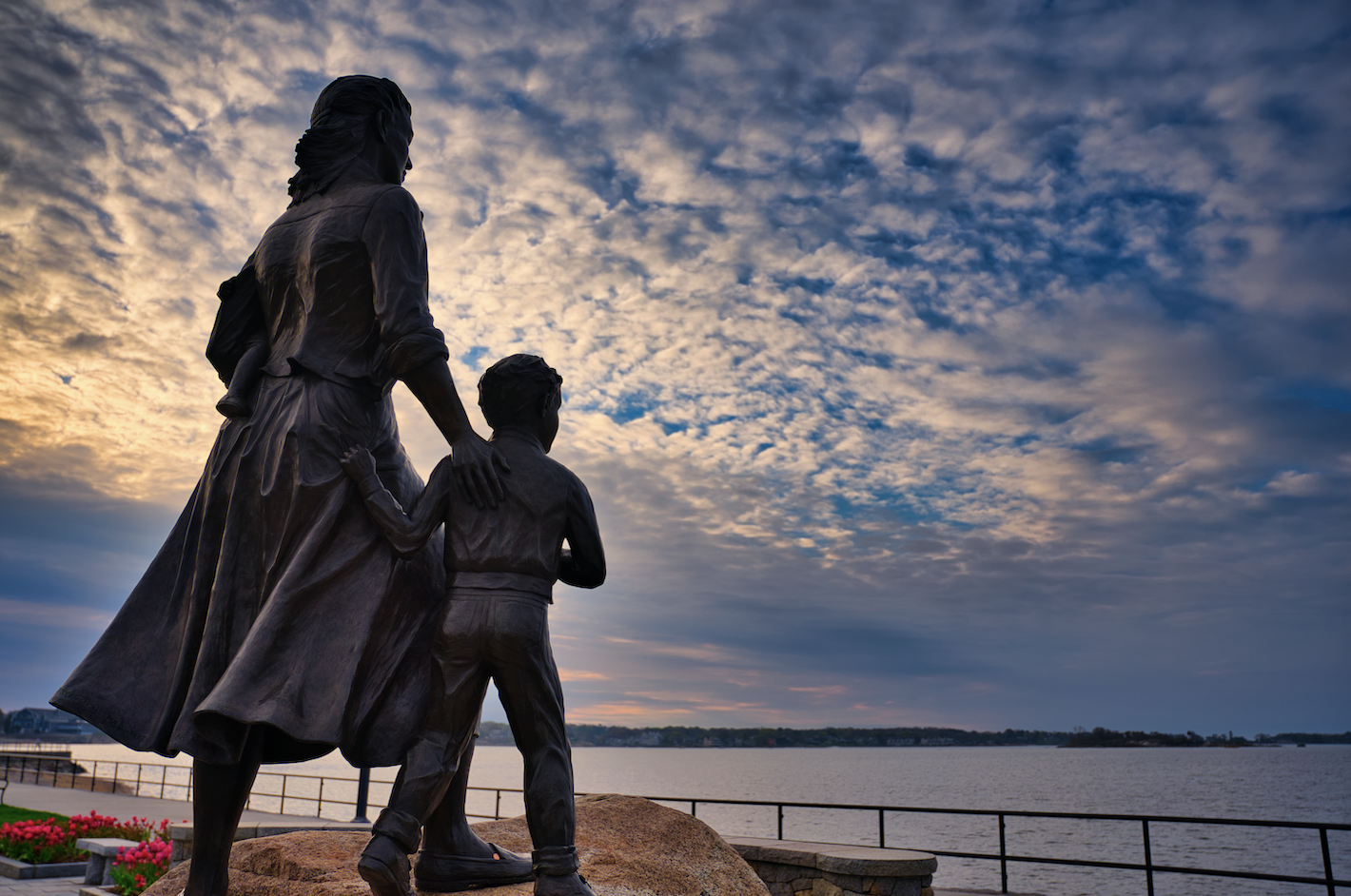Near the far end of Gloucester’s boulevard, a stretch of waterfront road that wraps around the city’s western harbor, stands a bronze statue. A woman, her feet braced against the wind, hoists a baby in her left arm and rests her right hand on the back of a young boy. She gazes seaward, watching, it seems, for the return of a fishing boat carrying her husband, her father, her brother.
The statue, the Fishermen’s Wives Memorial, does not draw the same attention as the iconic Man at the Wheel a few minutes’ walk to the east. But for Lyn Burke, the statue is at least as important as its more famous counterpart.
“These are strong women who have been holding up the community for hundreds of years,” says Burke, the founder of LuminArtz, a Gloucester-based nonprofit the produces light-based art installations.
So Burke decided her organization should do something to highlight the memorial—and everything it stands for—as the piece celebrates its 20th anniversary this year. The result of this inspiration was an immersive light and audio installation that takes place on August 5, the date the statue was first unveiled.
The installation bathed the memorial in a marine blue light and illuminated the granite paving stones around the statue, which are inscribed with names and messages from the donors who helped fund the project. The voices of local women telling their stories or struggle and success were broadcast intermixed with an original soundtrack composed by percussion artist Maria Finkelmeier.
Burke recalls the vision she had: “It will be immersive. Visitors will want to sit and listen to the voices.”
Gloucester has been a fishing community since it was first settled in the 17th century. The Gloucester Fishermen’s Wives Association was formed in 1969 to help defend Gloucester’s core industry from an influx of international fishing boats into waters off New England. Since then, the organization has worked to protect the rights and livelihoods of Gloucester fishermen.
The plan to create a monument to the women and children of the fishing industry was first conceived in the 1980s, when Lena Novello, one of the founders of the group, was searching through unsorted materials in the attic of the local library. She happened upon plans for a statue commemorating the women of Gloucester, including sketches and a small model prepared by Leonard Craske, the sculptor who’d designed the Man at the Wheel back in the 1920s.
The group initially hoped to build a statue based on these uncovered plans, but a debate over the rights to the materials derailed the idea. Determined to honor the women who came before them, the group decided to pursue a memorial based on a new design, explains Angela Sanfilippo, current president of the fishermen’s wives association.
“The women were the ones that really kept the community going,” Sanfilippo says. “The husbands used to go out for months and months. These women before us, they really endured a lot.”
They first put out a call for proposals in the early 1990s. Between choosing Morgan Faulds Pike as the artist, working with her to finalize a design, securing funding for the project, and actually creating the statue, it was nearly 10 years before the final memorial was unveiled on August 5, 2001. The group raised more than $700,000 for the project, much of which came from small donations.
“We wanted the $5, the $10, the $15,” Sanfilippo says. “We wanted everybody to look at the statue and say, ‘I helped. I contributed.’”
Last fall, Burke began planning an installation that would call attention to the statue—and the women it represents. As work progressed on the August event, she took a Gloucester harbor cruise with her mother and several female friends. Nearing the boulevard, the tour guide pointed out the Man at the Wheel, but didn’t even mention the fishermen’s wives statue. This omission galvanized Burke’s determination.
“It seemed like such validation that these strong women—and strong women everywhere—are not being heard,” she says.
Burke founded LuminArtz in 2015. She had been working in government relations when a friend, a curator with Australian light festival Vivid Sydney, asked for some help bringing an installation to the U.S. In the process, Burke realized there were many local artists doing similar work who would benefit from a dedicated organization that could help with production, coordination, and logistics.
In the years since its launch, LuminArtz has helped create installations across the state. The group produced a COVID-19 memorial in partnership with the Cape Ann Museum, lit up Boston’s Hatch Shell, and used the façade of the Boston Public Library as a canvas for a holiday light show.
While the fishermen’s wives memorial project may be smaller in scale than some of LuminArtz’s previous productions, it holds outsized meaning for Burke, as a Gloucester resident.
“This was something that was deep in my heart,” she says. “This is the platform to honor what they’ve done in our community.”
For more information, visit luminartz.org.

